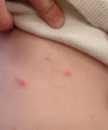Clinical Overview
On this Page
Varicella is an acute infectious disease. It is caused by varicella-zoster virus (VZV), which is a DNA virus that is a member of the herpesvirus group. After the primary infection, VZV stays in the body (in the sensory nerve ganglia) as a latent infection. Primary infection with VZV causes varicella. Reactivation of latent infection causes herpes zoster (shingles).
Clinical Features
Incubation Period and Prodrome

Characteristic pancorporeal varicella lesions in unvaccinated person.
The incubation period for varicella is 14 to 16 days after exposure to a varicella or a herpes zoster rash, with a range of 10 to 21 days. A mild prodrome of fever and malaise may occur 1 to 2 days before rash onset, particularly in adults. In children, the rash is often the first sign of disease.
Varicella in Unvaccinated Persons
The rash is generalized and pruritic (itchy). It progresses rapidly from macules to papules to vesicular lesions before crusting. The rash usually appears first on the head, chest, and back then spreads to the rest of the body. The lesions are usually most concentrated on the chest and back.
In healthy children, varicella is generally mild, with an itchy rash, malaise, and temperature up to 102°F for 2 to 3 days. Infants, adults, and immunocompromised people are at risk for more severe disease and have a higher incidence of complications. Recovery from primary varicella infection usually provides immunity for life. In otherwise healthy people, a second occurrence of varicella is uncommon and usually occurs in people who are immunocompromised. As with other viral infections, re-exposure to natural (wild-type) varicella may lead to re-infection that boosts antibody titers without causing illness or detectable viremia.
Varicella in Vaccinated Persons (Breakthrough Varicella)

Breakthrough varicella on the abdomen of a vaccinated child.
Breakthrough varicella is infection with wild-type VZV occurring in a vaccinated person more than 42 days after varicella vaccination. Breakthrough varicella is usually mild. Patients typically are afebrile or have low fever and develop fewer than 50 skin lesions. They usually have a shorter illness compared to unvaccinated people who get varicella. The rash is more likely to be predominantly maculopapular rather than vesicular. However, 25%-30% of persons vaccinated with 1 dose with breakthrough varicella have clinical features similar to those of varicella in unvaccinated people.
Since the clinical features of breakthrough varicella are often mild, it can be difficult to make a diagnosis on clinical presentation alone. Laboratory testing is increasingly important for confirming varicella and appropriately managing cases and their contacts. There is limited information about breakthrough varicella in persons who have received two doses of varicella vaccine, though it appears to occur less frequently and disease may be even milder among people vaccinated with two doses of varicella vaccine compared to persons who have received a single dose of varicella vaccine.
Top of PageComplications

X-ray of pneumonia caused by varicella.
The most common complications from varicella are
- bacterial infections of the skin and soft tissues in children
- pneumonia in adults
Severe complications caused by varicella include cerebellar ataxia, encephalitis, viral pneumonia, and hemorrhagic conditions. Other complications include septicemia, toxic shock syndrome, necrotizing fasciitis, osteomyelitis, bacterial pneumonia, and septic arthritis.
For research on serious infections and deaths following varicella, see References & Resources.
Transmission
Varicella is highly contagious. The virus can be spread from person to person by direct contact, inhalation of aerosols from vesicular fluid of skin lesions of acute varicella or zoster and possibly through infected respiratory secretions that also may be aerosolized. A person with varicella is contagious from 1-2 days before rash onset until the lesions have crusted. It takes from 10-21 days after exposure to the virus for someone to develop varicella. Based on studies of transmission among household members, about 90% of susceptible close contacts will get varicella after exposure to persons with disease.
People with breakthrough varicella are contagious. One study of varicella transmission in household settings found that persons with mild breakthrough varicella (< 50 lesions) were one third as contagious as unvaccinated persons with varicella. However, persons with breakthrough varicella with 50 or more lesions were just as contagious as unvaccinated persons.
Varicella is less contagious than measles but more so than mumps and rubella.
Related Pages
- Page last reviewed: July 1, 2016
- Page last updated: July 1, 2016
- Content source:


 ShareCompartir
ShareCompartir